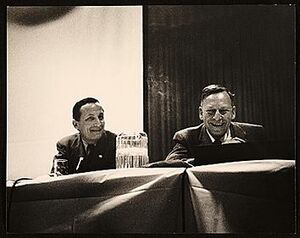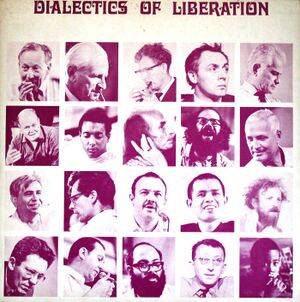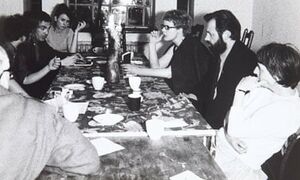Double Bind's Double life
GREGORY BATESON - ART – THERAPY– ECOLOGY

Gregory Bateson's ideas, which crossed between ecology and media ecology, were seminal in the development of video art in the late 1960s and early 1970s. Bateson had been a prominent and active voice in debates about art and society throughout the 1950s[1] which shifted emphasis away from the artistic product (the painting or sculpture) and toward the context in which such an object is created. Central to Bateson's cybernetic aesthetics was self-reflexivity (by the artist and the audience of art) as a condition of artistic production. In 1957 Bateson and Marcel Duchamp joined Frank Lloyd Wright and Mayer Shapiro at the American Federation of Arts Conference. It was here that Bateson outlined a (media) ecological understanding of art. Schipiro represented the old-guard, regarding painting's foremost virtue to be its fundamental opposition to mass media, a view which was opposed by Bateson and Duchamp.[2] Duchamp delivered his now famous paper The Creative Act with Bateson presenting a text entitled Creative Imagination which was later published in STEM.[3]
The 1957 conference was noteworthy because it attracted a much larger audience than expected and because there was an insistence from those presenting, and the audience to discuss communication systems in relation to the arts. This was in the wake of an increased mass media presence and as the discourse on cybernetics became accessible to more people through (for instance) Norbert Wiener's books, a popularisation of Claude Shannon’s Information Theory as well as Bateson's own writing, including Communication and the Social Matrix of Psychiatry (with Jurgen Ruesch). Duchamp's paper sidesteps Schipiro's conservative position and holds the communicative and medial nature of art to be beyond the intention of the artist. The public decodes or "deciphers" the intentions of the artist and in so doing become creators of it.[4]
Bateson's paper is more assuredly cybernetic in nature. The Creative Imagination addresses the particular nature of artistic communication, which, as opposed to everyday communication, is a means of meta-level communication, art for Bateson is inherently self-reflexive, it communicates about communication. If Schipiro was interested in art as a form of resistance, or bulwark, to communication, a space immune from the perennial effects of communication, Bateson sees art as a play between different levels of communication, a play which makes those different levels visible.[5].
This position would be the central tenet of early video art and the media theory discussed in Radical Software and would be a formative influence on artists such as Dan Graham (profoundly influenced by Bateson and Radical Software). For Bateson, aesthetic awareness allows for an understanding of the process by which it is possible to acquire knowledge. This produces the grounds on which a communications system is framed to be made visible, which for a generation of artists in the 1960s and 70s situated art as an inherently self-reflexive, self-critical and context-critical endeavour. For Bateson communication produces context and further reflection on the production of that context.[6]
This medial reading of aesthetics is in line with the valorization of creativity which was part of the post WWII's reinvention of the liberal subject: the self-reflexive self, constituted within media circuits (media-ecologies), which Bateson and Ruesch's Communication and the Social Matrix of Psychiatry had concerned itself. Here the self is beyond the individual subjectivity of ‘I’, mind is "immanent in the larger system, man plus environment. Communication is the "substance of common being".[7] Central to Bateson’s understanding of art was a conception of aesthetics as a form of ‘deutero-learning’ which deals with “context and classes of context” (as opposed to proto-learning which deals with “narrow fact”).[8]
When artistic practice and discourse finally adopted ideas of self-reflexivity and radical mediality in the late 1960s and early 1970s it was largely because of the influence Bateson had exacted on the counterculture from the 1960s on. Bateson’s vision of 'mind' as unbounded within a field of technological communication found resonance with a generation raised on the mass media and had also felt the alienating affects of that media. Many had also experienced some dissolution of the essential self through exposure to hallucinogenics, which provided a model demonstration of a self which is medial and co-exensive Gregory Bateson himself had been a participant in the CIA’s LSD experiments in the 1950s. [9] In 1959 Bateson helped arrange for his friend, the beat poet Allen Ginsberg, to take the drug at a research program located off the Stanford campus (see chapter E-Meter).[10] This was the same programme at which Ken Keasy and Stuart Brand met. Keasy and Brand went on to organise the multi-media Trips Festival in 1966. [11] In the following year Kesey and his Merry Pranksters boarded the magic bus and in 1968 Brand (a semi-detached merry prankster) founded the Whole Earth Catalog.[12]
The attitudes and practices of the 1960s counterculture were extended and re-coded into self-sufficient media ecologies as the 1970s approached, flowing through the output of media groups such as Raindance, TVTV (Top Value TeleVision), Ant Farm, The Woodstock Community Video and Videofreex.[13] In the era of second-order cybernetics the emphasis was on experiments in technologies of self – re-programming the system, programming the community. In the 1970s the "access to tools" was still an essential concern, along with an insistence that media should be aid cultural cohesion.
Within this context the conflated term ‘media ecology’ was developed in the pages of Radical Software in the early 1970s. Arlo Raymond attempted a definition in issue 1. Media ecology was, for him: :”the study of media and communications and its affect on media and society.”[14] In STEM, Bateson took a more radical position, within a media ecology there is no distinction among technology, affect, and sociability.[15]
THE DOUBLE-LIFE OF THE DOUBLE-BIND
Although Gregory Bateson would continue to be influential in the fields of psychoanalysis and psychiatry – particular in the fields of group therapy, video therapy and as one of the main inspirations for R.D. Laing’s “anti-psychiatry” movement in the 1960s – Bateson, had always had an ambiguous relationship with psychoanalysis and psychiatry. In fact his position had always been oblique, first entering as an anthropologist of the overall system of psychiatry and after that developing approaches which were out of the mainstream.
He left the field in 1962 to pursue research into octopus communication (Bateson held that octopi are capable of communicating abstractly). Following this, in 1962, Bateson joined John C. Lilly’s dolphin communication centre in the Virgin Islands.[16] Double-bind theory continued to be applied in practice as a diagnostic tool and continued to be applied within family-group therapy.
In 1977, returning to the subject of the double-bind for the major psychiatric conference, Beyond the Double Bind [17] Bateson expressed regret that the double-bind had been taken so literally and was frustrated by the oversimplistic applications afforded to the double-bind theory. He pointed out: “Double bind communication […] was a class of behavior not behavior itself and therefore was not quantifiable.” […] "You cannot count the number of double binds in a sample of behavior, just as you could not count the number of jokes in a comedian’s spiel or the number of bats in an inkblot." [18]
For Bateson the double-bind addressed epistemological questions which centred on the relationship between the name and that which is named; these elements are organised within a recursive structure, the double-bind is only useful insofar as it allows one to recognise that all communication is structured in this way.
Bateson: “The matrix, after all, is an epistemology, and specifically it is a recursive epistemology; at the same time, it is an epistemology of recursiveness, an epistemology of how things look, how we are to understand them if they are recursive, returning all the time to bite their own tails and control their own beginnings.” [19]
In cyberneticists feedback creates a homeostatic system, the particular outcomes of that system are not determined. Bateson’s approach to therapy reflected this point, each session would be defined by the particular context, allowing for a performative response to particular circumstances. By 1977 Bateson was repelled by the idea that the double-bind could be a therapy which promised quantifiable results, at the Beyond the Double-bind conference he stated: “ "I'm not very happy at feeling myself the father of the unsaid statement that 'double bind is a theory of therapy.' I do not think it is or was." [20]
Despite Bateson’s protestations, throughout the 1960s the double-bind found its practitioners as a theory and as a therapy. In the late 1960s and early 1970s, video increasingly became as the mediator within individual and group sessions and Bateson’s ideas remained central. Bateson's influence on the counterculture continued to grow, as a presence in Radical Software (as a media-ecologist) and as a key inspiration for Stewart Brand's Co-evolutionary Quarterly (1975).
CYBER-NARCOTICS

They are playing a game
They are playing at not playing a game. If I show them I see they are I
shall break the rules and they will punish me.
I must play their game of not seeing I see the game.
R.D Laing Knots I (1970)[21]
A brief recap; By the mid 1960s Bateson’s influence could be seen on a number of fronts
1) in the field of therapy (an emphasis on group therapy and the double-bind)
2) in the field of aesthetics (an emphasis on self-reflexive, context specific forms of art)
3) within the counterculture (a cybernetic epistemology and [media] ecology).
These influences are at times indirect and at other times explicit. All three strands converged in the pages of Radical Software, in which the tendency to understand video as a medium of self-knowledge, and knowledge of context, crossed into the counterculture with mercurial ease.
It was in the pages of radical Software that video therapists Harry Wilmer and Milton Berger, artists Paul Ryan and Frank Gillette and Bateson himself unified the fields of group therapy, aesthetic expression and (media) ecology . The centrality of video as a technology of self-exploration found close proximity to an understanding of LSD as a technology of the self.
An earlier manifestation of the meeting of cybernetic readings of therapy, aesthetics and context-reflexivity was evident in the Dialectic of Liberation summit in London in 1967. The summit was convened by Dr. R.D. Laing, who in 1965 had established Kingsley Hall, in London. Kingsley Hall became centre of what came to be known as the "anti-psychiatry" movement [22]– which sought to break down the hierarchy between staff and patients and which opposed a “vivisectionist” tendency in mainstream psychiatry, had no locks on the doors, allowed people to come and go at leisure, involved patients in decision making process, did not prescribe (traditional) drugs– and, as such, became the testing ground for alternative ways of living that could extend beyond the walls of the institution.
Laing’s early research included what came to be known as the “rumpus room” experiment at Glasgow Royal Mental Hospital (1955), [23]Here eleven socially isolated chronic schizophrenics and two nursing staff were confined in a room every day over the course of one year. The staff were given no specific instructions about how they should interact or how they should conduct treatment. This experiment was conducted in a context in which the management of the ward was very hierarchical and the contact between patients and staff was minimal. The experiment showed that more intimate contact with the patients meant that behaviour of the patients and the nursing staff changed. “The patients lost many of the features of chronic psychoses; they were less violent to each other and to the staff, they were less dishevelled, and their language ceased to be obscene.” [24]
The modality of the experiment indicated a move toward a more social psychiatry,[25] in which the hierarchies of traditional psychiatric treatment are replaced by more “bottom up” system of day-to-day management. The Glasgow study also revealed tensions between the structures of the institution and the less hierarchical practices modelled in the experiment. It also understood the psychiatric process as adaptive, that all parties within the environment would change through a process. The task of the carer was to enter this process.
In 1965 Laing, now at the Tavistock Clinic, joined a group of colleagues [26] to form the charity the Philadelphia Association, which opened Kingsley Hall in East London. The aim was to create a model for non-vivisectionist, non-restraining therapies for people seriously affected by schizophrenia.
Laing had encountered Bateson’s ideas in the late 1950s and was attracted to the idea of the double bind and also to Bateson’s reading of psychosis as an adaptive, progressive process (a journey). Laing visited Bateson and the Double-bind research group at Palo Alto in 1962.[27] Laing’s interpretation of the double-bind, however, was not reliant on The Theory of Types. Laing would argue that schizophrenia is a response to an impossible situation which arises within the system – the causation does not rest with the mother but is a rather a distorted equilibrium within a given group. The task was to create an environment where a new equilibrium could be established.
[??]Here Laing began to use LSD within a group and individual context. As a technology of self, LSD made the user aware of the interconnectedness of things and blurred essential entities – [??!!]
the rest
The ease with which the practice of video therapy shifted from the clinical context into lived cultural experience is a testament to the protean quality of cybernetic discourse. A similar cultural shift occurred when the centre of the "anti-psychiatry" movement Kingsley Hall, in London became a countercultural testing ground which proposed alternative ways of living which could be applied beyond the walls of the institution. It was within this culture, the central figure of which was the psychoanalyst R.D Laing, that counterculture summit, Dialectics of Liberation (1967), which brought together the intellectual leaders of the counterculture (including Gregory Bateson, Allen Ginsberg and William Burroughs) was staged [continue]

[...] The tendency to understand video as a medium of self-knowledge, and knowledge of context, crossed into the counterculture automatically.
R.D. Laing's early research in which medical staff worked alongside patients . ... which led to the residential treatment centre Kingsley Hall the "anti-psychiatry" movement...
Knots is curiously "Batsonian" because it deals poetically with the double-bind (without explicit reference to Whitehead or Russell)...
- ↑ For instance, Bateson was a member of the Western Roundtable on Modern Art in San Francisco in 1949, which included Marcel Duchamp.
- ↑ William Kaizen, Steps to an Ecology of Communication: Radical Software, Dan Graham, and the Legacy of Gregory Bateson: Art Journal, Vol. 67, No. 3 (FALL 2008), pp. 86-107, p92
- ↑ M.Duchamp The Creative Act, ART-news Vol. 56, no. 4, 1957
- ↑ M.Duchamp The Creative Act, ART-news Vol. 56, no. 4, 1957
- ↑ Gregory Bateson The Creative Imagination Stem p
- ↑ William Kaizen, Steps to an Ecology of Communication: Radical Software, Dan Graham, and the Legacy of Gregory Bateson: Art Journal, Vol. 67, No. 3 (FALL 2008), pp. 86-107 pp. 93-94
- ↑ Bateson, in William Kaizen, Steps to an Ecology of Communication: Radical Software, Dan Graham, and the Legacy of Gregory Bateson: Art Journal, Vol. 67, No. 3 (FALL 2008), pp. 86-107, p94
- ↑ Bateson, Mind and Nature, 156
- ↑ The drug was administered to him by CIA agent Harold Abramson.
- ↑ Marks 1979:120
- ↑ Turner; From Counterculture to Cyberculture, University of Chicago Press, 2008
- ↑ Bateson, through his friendship with Alan Watts, also took an interest in Zen Buddhism as the model for a non-occidental, radically discentered, non-Cartesian philosophy STEVE P. HEIMS: Journal of the History of the Behavioral Sciences 13 ; GREGORY BATESON AND THE MATHEMATICIANS: FROM INTERDISCIPLINARY INTERACTION TO SOCIETAL FUNCTIONS 1977, 141-159
- ↑ David Joselit Feedback: Television Against Democracy, MIT Press 2007
- ↑ Arlo Raymond, Media Ecology Radical Software Issue 1
- ↑ Bateson STEM. 87
- ↑ With a grant from the National Science Foundation Bateson studied the coding of analogic–nonverbal–signals in octopi. In 1962 Bateson took up a research position at John C. Lilly’s dolphin communication centre in the Virgin Islands. .See Lipsit p233
- ↑ Cited in Lipset: Beyond the Double-bind, New York City, which was sponsored by the South Beach Psychiatric Center, of Staten Island. Those attending included Gregory Bateson, Milton M. Berger, M.D, John Weakland, Murray Bowen, M.D., and Carl A. Whitaker, M.D., Albert E. Schefflin, M.D., and Lyman C. Wynn, M.D. Lipset p. p.294
- ↑ Cited in Lipset: Gregory Bateson: "The birth of a matrix or double bind and epistemology, " in Beyond the Double Bind,p. 41.
- ↑ Cited in Lipset: Gregory Bateson: "The birth of a matrix or double bind and epistemology, " in Beyond the Double Bind, p. 41.
- ↑ Cited in Lipset: J. Haley, "Ideas which handicap therapists," in Beyond the Double Bind, pp. 65-80.
- ↑ R.D Lang Knots p.1 Penguin 1971
- ↑ A. Pickering points out in the Cybernetic Brain p 438: “The term “antipsychiatry” seems to have been put into circulation by Laing’s colleague David Cooper in his book Psychiatry and Anti-psychiatry (1967), but Laing never described himself as an “antipsychiatrist.”
- ↑ Cameron, J. L., R. D. Laing, and A. McGhie (1955) “Patient and Nurse: Effects of Environmental Change in the Care of Chronic Schizophrenics,” Lancet, 266 (31 December), 13 84–86.
- ↑ In Pickering: Cameron, J. L., R. D. Laing, and A. McGhie (1955) “Patient and Nurse: Effects of Environmental Change in the Care of Chronic Schizophrenics,” Lancet, 266 (31 December), 13 84–86.
- ↑ see also David Cooper’s experimental psychiatric ward, Villa 21, at Shenley Hospital
- ↑ David Cooper, Joseph Berke, Aaron Esterson, writer Clancy Sigal
- ↑ Lipsett p.238